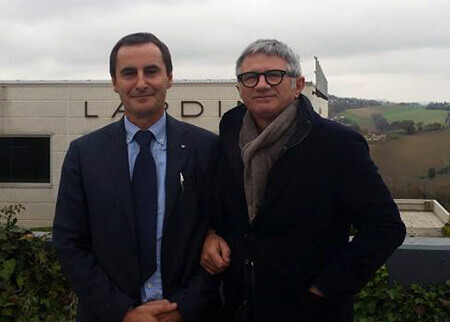Andrea Lardini

CEO of Lardini SpA, Client of Manini Prefabbricati
Lardini: The Pride of Italian Fashion
This is the story of a family, the Lardini family from Filottrano, a small town in the Marche region, in the province of Ancona.
It’s the story of a young man with a passion for fashion, endowed with a talent for style and an innate attraction to beautiful things.
It’s the story of his siblings who believed in him and a father who bet on that young people’s project.
It’s 1978, and a clothing line is born that already contains in its name the desire to do things on a grand scale: the Gulliver Look collection doesn’t achieve great success, but the tailoring workshop that produced it attracts attention in the Italian fashion scene and beyond.
This is the beginning of Andrea Lardini’s story, now CEO of Lardini, a company that in 2014 exceeded 70 million in turnover.
The CEO welcomes us in his office, adorned with official recognitions and family photos, and continues to speak enthusiastically about more than 30 years of work, satisfactions, difficulties, and successes.
He tells us about his brother Luigi, the designer, the creative one; about his sister Lorena, who immediately took care of the administrative part; and about his other sister Anna Rita, the youngest, who joined the company later with the responsibility of quality control of the garments.
Andrea Lardini is a talkative man, full of energy, and he describes his company as a living entity ‘…like a vital organism, a beating heart, a breathing lung, a unique body that lives and grows in unison, where every component works and moves with the intent of achieving the same result, the same goal…’
When we ask him what have been the keys to success over these years, he responds that ‘…a company grows when it has a vision, a strategy, when it focuses and invests in innovation and research without ever losing sight of the market situation and needs…’
‘…sometimes, however, you also need a good dose of luck…’ – he smiles and tells us how in the early nineties, after a long experience as subcontractors producing for major brands of the time including Jenny, Ungaro, and Versace, they tried again to create their own line.
‘…as dictated by the fashion of the time, we designed wide jackets, with important shoulders, in cashmere. However, during the manufacturing process, something didn’t work out, and in the end, the garments turned out much smaller and tighter than they were designed to be…they were a success!…’
Fashion, after all, is undisciplined, it’s variety, change, one must have attentive eyes and the right sensitivity to interpret what the market will demand tomorrow. Sometimes a bit of luck helps, but only a good system and method are the elements that guarantee and consolidate success.
In 1993, the Lardini brand is finally born, as we know it today, a brand recognized as an excellence in Made in Italy in the production of men’s and now also women’s fashion, with its unmistakable little flower, a unique and original symbol of the signature.
Now the Lardini brand, which constitutes 30-35% of the group’s production, continues to grow steadily, loved in Scandinavian countries, in Korea, in Russia, and acclaimed in Japan.
‘Growth at this moment,’ Andrea Lardini confides to us, ‘is so strong that we are organizing to support it with new human resources and real estate investments.’
The Group has a showroom in New York and one in Milan, on Via Manzoni, which it intends to expand and perhaps soon double. By February 2015, the expansion of the Filottrano plant will be completed, adding about 9,000 square meters to the current 11,000, for which Lardini has chosen Manini Prefabbricati SpA as the supplier.
So we ask him how he came to know our company and the reason for his choice.
‘I’ve always known Manini,’ Lardini confides to us, ‘…I think it’s an excellence of Made in Italy in its sector, and I feel very close to it because you can sense that behind it are the solid values of a family company, like us, after all…’
Family. A recurring word in Andrea Lardini’s story, an indispensable value.
And alongside family, there are the values of the land where one was born, the roots that are fundamental even when flying to a foreign country every week, different in language, customs, and thought.
‘Every time, however,’ Andrea tells us, almost moved, ‘…it’s nice to return to Filottrano, to family, to home, among those Marche valleys that saw us grow…’
